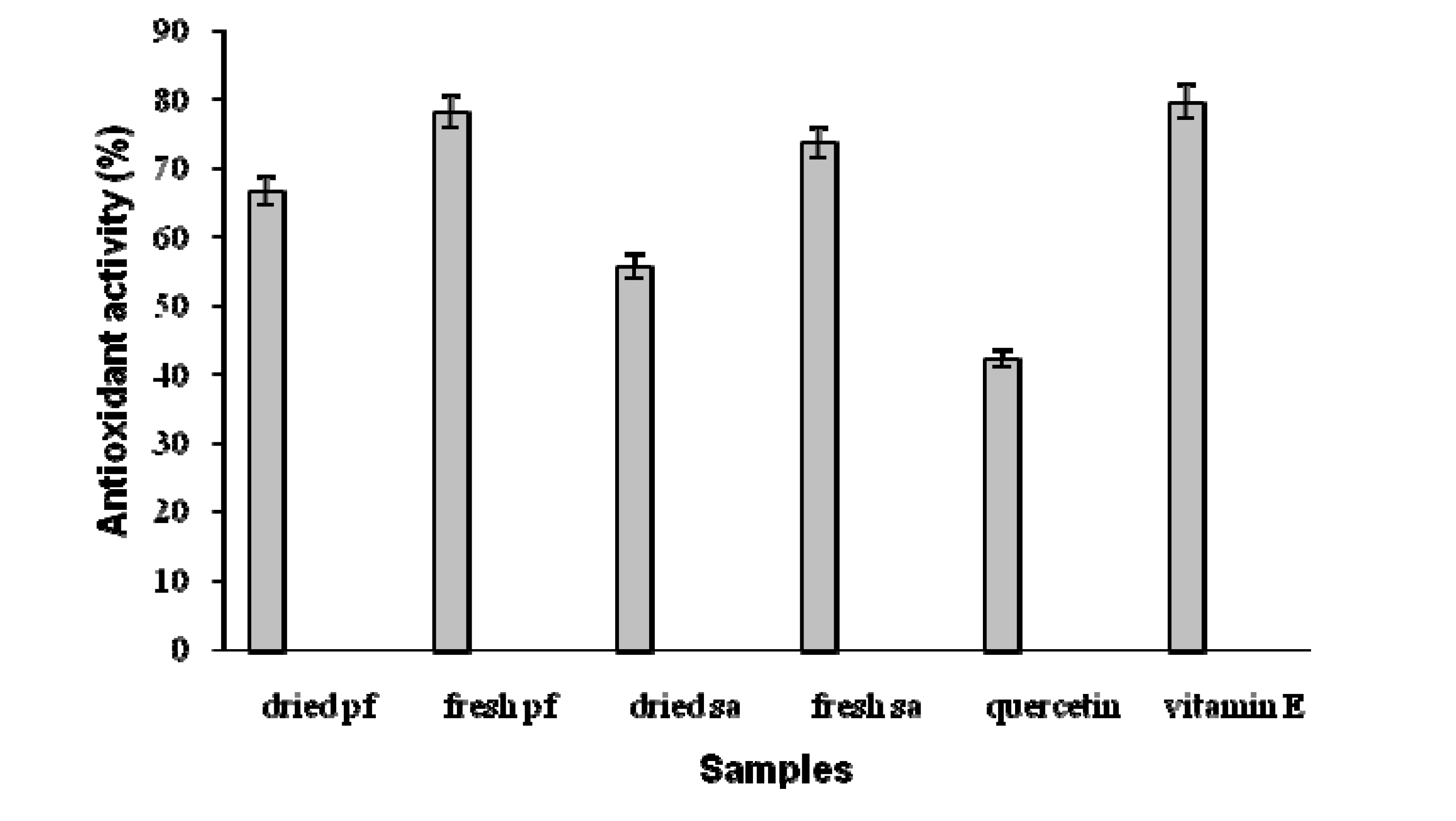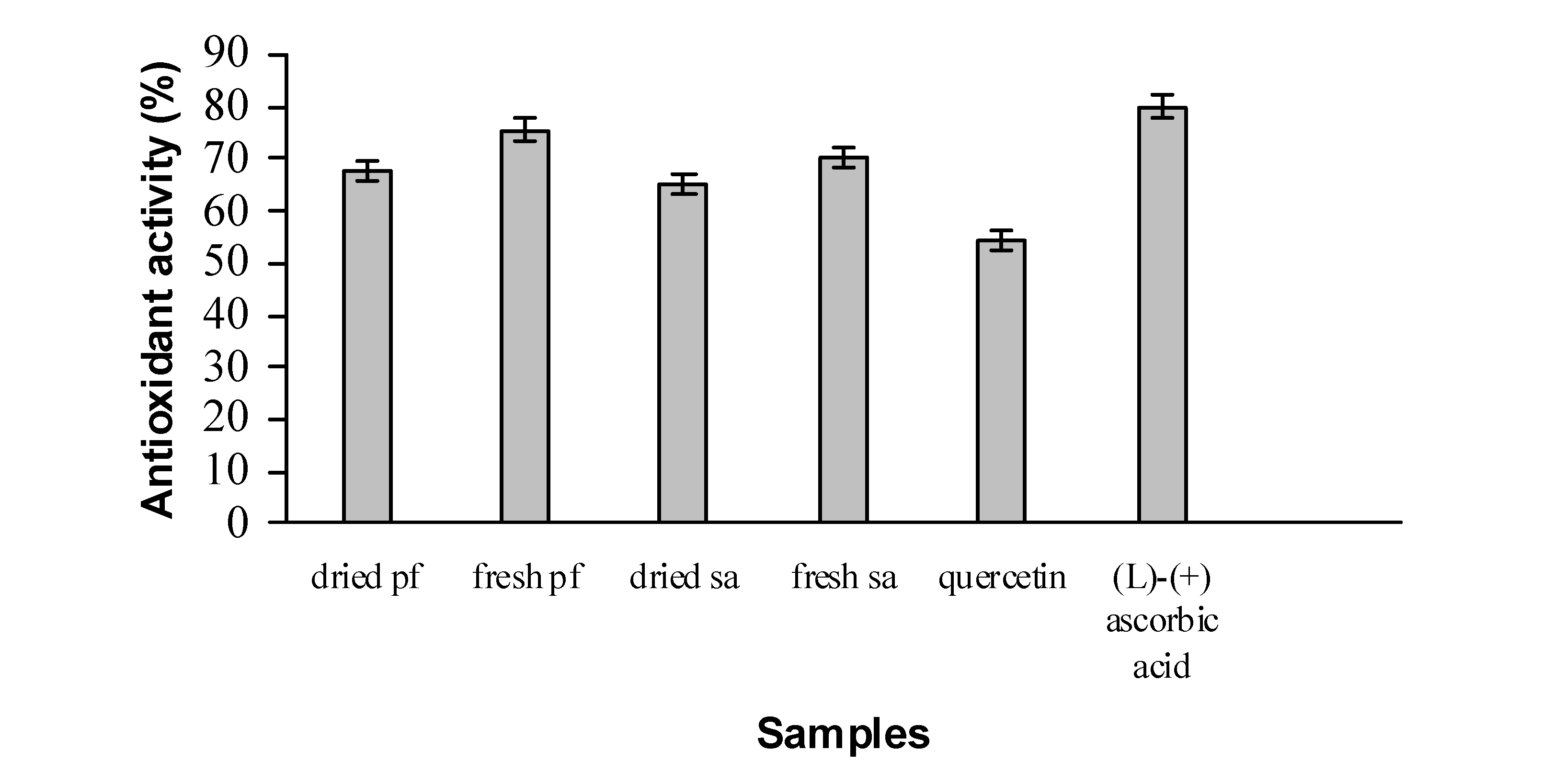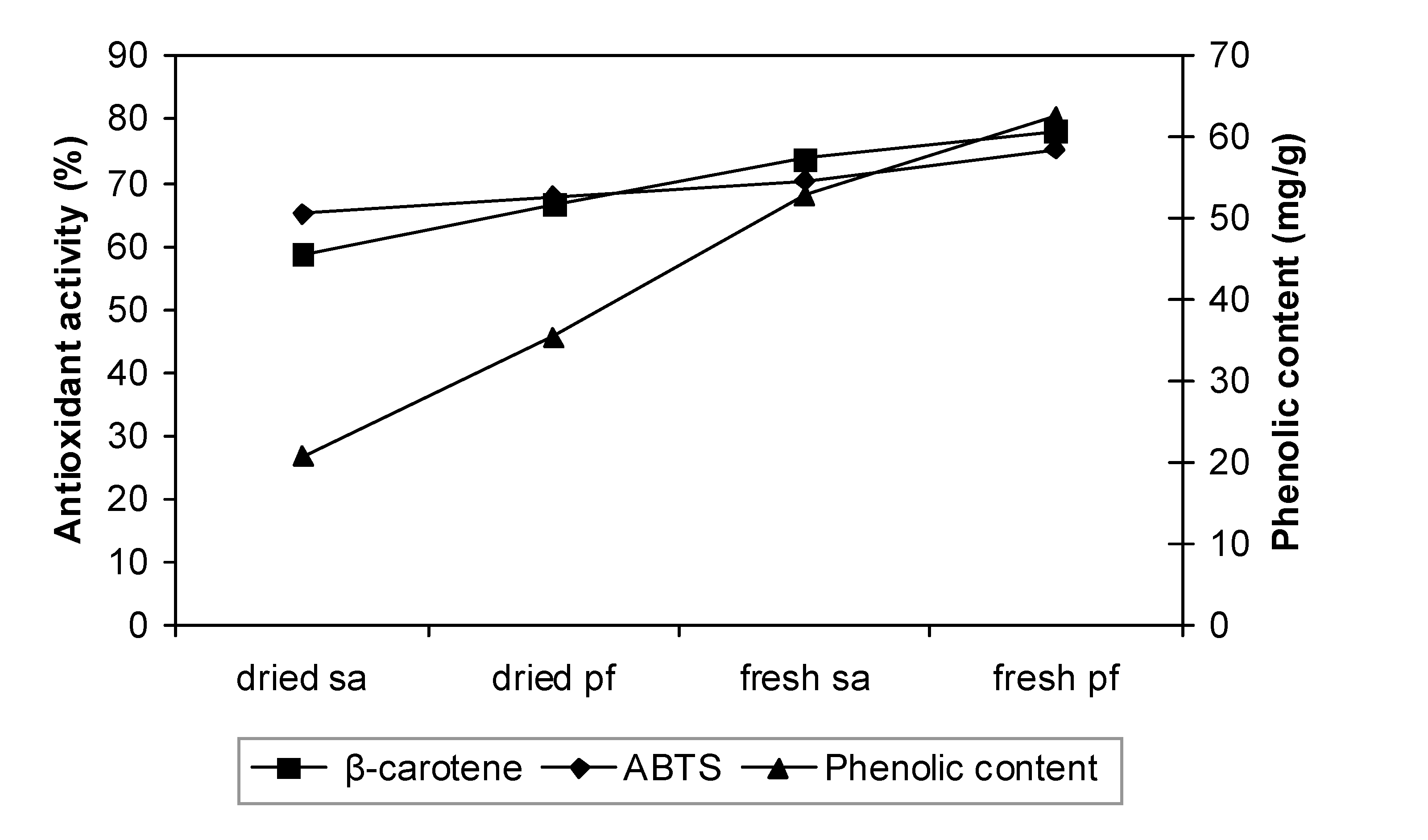Antioxidant Activity and Phenolic Content of Paederia foetida and Syzygium aqueum
Abstract
:Introduction
Results and Discussion
Extraction
Antioxidant activity
Coupled oxidation of β-carotene and linoleic acid

ABTS free radical-scavenging activity


Total phenolic content of the plant extracts
| Samples | FAb |
|---|---|
| P. foetida leaves (dried) | 35.52 ± 1.64 |
| P. foetida leaves (fresh) | 62.64 ± 1.32 |
| S. aqueum leaves (dried) | 20.77 ± 0.34 |
| S. aqueum leaves (fresh) | 52.96 ± 1.62 |
| P. foetida twig (dried) | 20.8 ± 3.25 |
| P. foetida twig (fresh) | 60.93 ± 3.40 |
Correlation between two methods of antioxidant activity
| Samples | Antioxidant (%)(β-carotene) method | Antioxidant (%)(ABTS) method |
|---|---|---|
| S. aqueum Leaves (fresh) | 73.77 | 70.31 |
| S. aqueum Leaves (dried) | 58.73 | 65.08 |
| P. foetida Leaves (fresh) | 78.13 | 75.38 |
| P. foetida Leaves (dried) | 66.67 | 67.74 |
Correlation between phenolic content and antioxidant activity

Conclusions
Experimental
Preparation of samples
Preparation of extracts
Antioxidant activity
Coupled oxidation of β-carotene and linoleic acid
ABTS free radical scavenging activity
Quantitative determination of total phenolic content
Acknowledgements
References and Notes
- Malenčić, D.; Popović, M.; Miladinović, J. Phenolic content and antioxidant properties of soybean (Glycine max (L.) Merr. Seeds. Molecules 2007, 12, 576–581. [Google Scholar] [CrossRef]
- Andlauer, W.; Fürst, P. Antioxidative power of phytochemicals with special reference to cereals. Cereal Foods World 1998, 43, 356–60. [Google Scholar]
- Amin, I.; Tan, S.H. Antioxidant activity of selected commercial seaweeds. Malays. J. Nutr. 2002, 8, 167–177. [Google Scholar]
- Ochse, J.J.; van den Brick, R.C.B. Vegetables of the Dutch East Indies; A.Asher & Co: Amsterdam, The Netherland, 1977. [Google Scholar]
- Ghani, A. Medicinal Plants of Bangladesh-Chemical Constituents and Uses, 2nd Ed. ed; Asiatic Society of Bangladesh: Dhaka, Bangladesh, 1998. [Google Scholar]
- Afroz, S.; Alamgir, M.; Khan, M.T.H.; Jabbar, S.; Nahar, N.; Choudhuri, M.S.K. Antidiarrhoeal activity of the ethanol extracts of Paederia foetida Linn. (Rubiaceae). J. Ethnopharm. 2006, 105, 125–130. [Google Scholar] [CrossRef]
- Shukla, Y.N.; Lloyd, H.A.; Morton, J.F.; Kapadia, G.J. Iridoid glycosides and other constituent of Paederia foetida. Phytochemistry 1976, 15, 1989–1990. [Google Scholar] [CrossRef]
- Wong, K.C.; Tan, G.L. Steam Volatile Constituents of the Aerial Parts of Paederia foetida L. Flavour Fragr. J. 1994, 9, 25–28. [Google Scholar]
- Morton, J.F. Fruits of Warms Climates; Julia, F. Morton Publisher: Miami, FL, USA, 1987. [Google Scholar]
- Wong, K.C.; Lai, F.Y. Volatile constituents from fruits of four Syzygium species grown in Malaysia. Flavour Fragr. J. 1996, 11, 61–66. [Google Scholar] [CrossRef]
- Okuda, T.; Yoshida, T.; Hatano, T.; Yazaki, K.; Ashida, M. Ellagitannins of the casuarinaceae, stachyuraceae and myrtaceae. Phytochemistry 1982, 21, 2871. [Google Scholar]
- Dasgupta N.; De, B. Antioxidant activity of some leafy vegetables of India: A comparative study. Food Chem. 2007, 101, 471–474. [Google Scholar] [CrossRef]
- Lim, Y.Y.; Lim, T.T.; Tee, J.J. Antioxidant properties of several fruits: A comparative study. Food Chem. 2007, 103, 1003–1008. [Google Scholar] [CrossRef]
- Velioglu, Y.S.; Mazza, G.; Gao, L.; Oomah, B.D. Antioxidant activity and total phenolics in selected fruits and vegetables, and grain products. J. Agric. Food Chem. 1998, 46, 4113–4117. [Google Scholar] [CrossRef]
- Jayaprakasha, G.K.; Singh, R.P.; Sakariah, K.K. Antioxidant activity of grape seed (Vitis vinifera) extracts on peroxidation modls in vitro. Food Chem. 2001, 73, 288–290. [Google Scholar]
- Amin, I.; Zamaliah, M.M.; Chin, W.F. Total Antioxidant activity and phenolic content in selected vegetables. Food Chem. 2004, 582–586. [Google Scholar]
- Gimlette, J.D.; Thomson, H.W. A Dictionary of Malayan Medicine. Oxford University Press: New York, USA, 1971. [Google Scholar]
- Holmes, E.M. Malay Materia Medica. Bull. Pharm. 1892, 108–117. [Google Scholar]
- Kaur, C.; Kapoor, H.C. Antioxidant activity and total phenolic content of some Asian vegetables. Int. J. Food Sci. Tech. 2002, 37, 153–161. [Google Scholar] [CrossRef]
- Cai, Y.Z.; Sun, M.; Xing, J.; Luo, Q.; Corke, H. Structure radical-scavenging activity relationships of phenolic compounds from traditional chinese medicinal plants. Life Sci. 2006, 78, 2872–2888. [Google Scholar] [CrossRef]
- Miller, H.E. A simplified method for the evaluation of antioxidants. J. Am. Oil Chem. Soc. 1971, 18, 439–452. [Google Scholar]
- Elzaawely, A.A.; Xuan, T.D.; Tawata, S. Essential oils, kava pyrones and phenolic compounds from leaves and rhizomes of Alpinia zerumbet (Pers.) B.L. Burtt. & R.M. Sm. and their antioxidant activity. Food Chem 2007, 103, 486–494. [Google Scholar] [CrossRef]
- Goh, L.M.; Barlow, P.J.; Yong, C.S. Examination of antioxidant activity of Ginkgo biloba leaf infusions. Food Chem. 2003, 82, 275–282. [Google Scholar] [CrossRef]
- Rahim, A.A.; Rocca, E.; Steinmetz, J.; Kassim, M.J.; Ibrahim, M.S.; Osman, H. Antioxidant activities of mangrove Rhizophora apiculata bark extracts. Food Chem. 2008, 107, 200–207. [Google Scholar]
- Edeoga, H.O.; Okwu, D.E.; Mbaebie, B.O. Phytochemical constituents of some Nigerian medicinal plants. Afr. J. Biotechnol. 2005, 4, 685–688. [Google Scholar]
- Sample Availability: Not available.
© 2009 by the authors; licensee Molecular Diversity Preservation International, Basel, Switzerland. This article is an open-access article distributed under the terms and conditions of the Creative Commons Attribution license ( http://creativecommons.org/licenses/by/3.0/).
Share and Cite
Osman, H.; Rahim, A.A.; Isa, N.M.; Bakhir, N.M. Antioxidant Activity and Phenolic Content of Paederia foetida and Syzygium aqueum. Molecules 2009, 14, 970-978. https://doi.org/10.3390/molecules14030970
Osman H, Rahim AA, Isa NM, Bakhir NM. Antioxidant Activity and Phenolic Content of Paederia foetida and Syzygium aqueum. Molecules. 2009; 14(3):970-978. https://doi.org/10.3390/molecules14030970
Chicago/Turabian StyleOsman, Hasnah, Afidah A. Rahim, Norhafizah M. Isa, and Nornaemah M. Bakhir. 2009. "Antioxidant Activity and Phenolic Content of Paederia foetida and Syzygium aqueum" Molecules 14, no. 3: 970-978. https://doi.org/10.3390/molecules14030970




